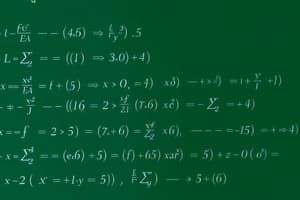Podcast
Questions and Answers
Which of the following expressions demonstrates the correct application of the distributive property?
Which of the following expressions demonstrates the correct application of the distributive property?
- $4(x + y) = 4x + y$
- $2(3x + 4) = 5x + 6$
- $5(x + 2) = 5x + 2$
- $3(2x - 1) = 6x - 3$ (correct)
Given the equation $4x - 7 = 5$, what is the value of $x$?
Given the equation $4x - 7 = 5$, what is the value of $x$?
- $x = 2$
- $x = 4$
- $x = 3$ (correct)
- $x = 1$
Simplify the following expression by combining like terms: $7a + 3b - 4a + 2b$
Simplify the following expression by combining like terms: $7a + 3b - 4a + 2b$
- $10ab$
- $11a + 5b$
- $3a + 5b$ (correct)
- $3a + b$
Which of the following represents a quadratic equation?
Which of the following represents a quadratic equation?
Solve for $x$ in the inequality: $2x + 5 < 11$
Solve for $x$ in the inequality: $2x + 5 < 11$
What is the value of $|-9|$?
What is the value of $|-9|$?
Given the system of equations:
$x + y = 7$
$x - y = 1$
What is the solution for $x$ and $y$?
Given the system of equations:
$x + y = 7$ $x - y = 1$
What is the solution for $x$ and $y$?
Factor the following expression: $4x + 8$
Factor the following expression: $4x + 8$
What is the correct order of operations (PEMDAS) for simplifying an expression?
What is the correct order of operations (PEMDAS) for simplifying an expression?
Identify the coefficient in the term $7y$.
Identify the coefficient in the term $7y$.
Flashcards
Variables
Variables
Symbols representing unknown or changeable values.
Constants
Constants
Fixed values that do not change in an expression.
Algebraic Expressions
Algebraic Expressions
Combinations of variables, constants, and operations (+, -, ×, ÷) without an equals sign.
Equations
Equations
Signup and view all the flashcards
Terms
Terms
Signup and view all the flashcards
Coefficients
Coefficients
Signup and view all the flashcards
Order of Operations
Order of Operations
Signup and view all the flashcards
Like Terms
Like Terms
Signup and view all the flashcards
Distributive Property
Distributive Property
Signup and view all the flashcards
Factoring
Factoring
Signup and view all the flashcards
Study Notes
- Basic algebra deals with symbols and rules for manipulating them.
- It generalizes arithmetic by extending numbers and operations to variables and algebraic expressions.
Variables
- Variables are symbols, usually letters, representing unknown or changeable values.
- They express relationships and facilitate general problem-solving.
- In "3x + 5," x is a variable.
Constants
- Constants are fixed values within an expression.
- In "3x + 5," 3 and 5 are constants.
Algebraic Expressions
- Algebraic expressions combine variables, constants, and math operations (+, -, ×, ÷).
- They do not contain an equals sign (=).
- Examples include 3x + 5, 2y - 7, and a^2 + b^2.
Equations
- Equations show the equality between two algebraic expressions.
- They include an equals sign (=).
- Examples include 3x + 5 = 14, 2y - 7 = 9, and a^2 + b^2 = c^2.
Terms
- Terms are components of an algebraic expression, separated by + or - signs.
- In "3x + 5," 3x and 5 are considered terms.
Coefficients
- Coefficients are numerical parts of a term that includes a variable.
- In "3x," 3 is the coefficient.
Basic Operations
- The basic operations in algebra include addition, subtraction, multiplication, and division.
- These operations are used to manipulate algebraic expressions and equations.
Addition
- Combining like terms involves adding their coefficients.
- For example: 3x + 2x = 5x
Subtraction
- Similar to addition, subtraction combines like terms by subtracting coefficients.
- For example: 5y - 2y = 3y
Multiplication
- Multiplying algebraic expressions means distributing each term of one expression to each term of the other.
- For example: 2(x + 3) = 2x + 6
Division
- Dividing algebraic expressions may involve simplifying fractions or using long division.
- For example: (6x + 9) / 3 = 2x + 3
Order of Operations
- PEMDAS (Parentheses, Exponents, Multiplication and Division, Addition and Subtraction) dictates the sequence of operations.
- The order ensures consistency when evaluating expressions: Parentheses/brackets first, then exponents/roots, multiplication/division (left to right), and addition/subtraction (left to right).
- For example: 2 + 3 × 4 = 2 + 12 = 14 (multiplication occurs before addition).
Simplifying Expressions
- Simplifying includes combining like terms, applying the distributive property, and factoring.
Combining Like Terms
- Like terms have the same variable raised to the same power.
- Combine like terms by adding or subtracting their coefficients.
- For example: 3x^2 + 2x^2 - x + 4x = 5x^2 + 3x
Distributive Property
- The distributive property is a(b + c) = ab + ac.
- It removes parentheses in algebraic expressions.
- For example: 4(2x - 5) = 8x - 20
Factoring
- Factoring reverses the distributive property.
- Factoring expresses an algebraic expression as a product of its factors.
- For example: 6x + 9 = 3(2x + 3)
Solving Equations
- Solving equations means finding variable values that make the equation true.
- Use inverse operations to isolate the variable.
Linear Equations
- Linear equations have a highest variable power of 1.
- They are written as ax + b = c, where a, b, and c are constants.
- Solve by isolating the variable using inverse operations, adding/subtracting constants, and dividing/multiplying by the variable's coefficient.
- Example: Solve 2x + 3 = 7
- 2x = 7 - 3
- 2x = 4
- x = 4 / 2
- x = 2
Quadratic Equations
- Quadratic equations have a highest variable power of 2.
- They are written as ax^2 + bx + c = 0, where a, b, and c are constants and a ≠ 0.
- Solve by factoring, completing the square, or using the quadratic formula: x = (-b ± √(b^2 - 4ac)) / (2a).
- Factoring expresses the quadratic expression as a product of two binomials.
- Completing the square manipulates the equation to form a perfect square trinomial.
- Example: Solve x^2 - 5x + 6 = 0
- (x - 2)(x - 3) = 0
- x = 2 or x = 3
Systems of Equations
- These are sets of two or more equations with the same variables.
- Solving involves finding variable values that satisfy all equations simultaneously via substitution, elimination, or graphing.
- Substitution solves one equation for a variable and substitutes that expression into another equation.
- Elimination adds or subtracts equations to eliminate a variable.
- Graphing plots equations to find intersection points.
- Example: Solve the system of equations:
- x + y = 5
- x - y = 1
- Adding the two equations gives:
- 2x = 6
- x = 3
- Substituting x = 3 into the first equation gives:
- 3 + y = 5
- y = 2
- Therefore, the solution is x = 3 and y = 2.
Inequalities
- Inequalities compare expressions using symbols like <, >, ≤, and ≥.
- Solving finds the range of variable values that make the inequality true.
Linear Inequalities
- These are inequalities with a highest variable power of 1.
- They are written as ax + b < c, ax + b > c, ax + b ≤ c, or ax + b ≥ c, where a, b, and c are constants.
- Solving is like solving linear equations, except multiplying/dividing by a negative number reverses the inequality sign.
- Example: Solve 3x - 2 > 7
- 3x > 9
- x > 3
Absolute Value
- A number's absolute value is its distance from zero on the number line, denoted |x|.
- Absolute value is always non-negative.
- Example: |-5| = 5 and |5| = 5
Studying That Suits You
Use AI to generate personalized quizzes and flashcards to suit your learning preferences.




